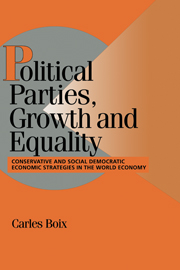 Political Parties, Growth and Equality
Political Parties, Growth and Equality Published online by Cambridge University Press: 05 June 2012
Apart from providing physical and human capital directly through the public budget, whose political determinants have been explored in Chapter 3, the government may equally choose to shape the supply conditions of the economy by “indirect” means. The state may affect the provision of supply factors through the creation of a public business sector. Also, it may affect the levels of both domestic savings and private investment through tax and regulatory measures.
This chapter starts by examining the political factors that motivated the distinct strategies that OECD nations have been pursuing toward the public business sector since the late 1980s. Besides confirming again the key role partisan forces have played, this first section highlights how increasingly strained economic conditions (since the mid-1970s) broke down an already tepid consensus around postwar industrial policies and generated substantially divergent policy responses across the political space. The second section then explores the evolution of tax policies. In light of the empirical results obtained in both this chapter and Chapter 3, the third section offers a first appraisal of the political dimensions of economic policymaking in advanced nations.
STRATEGIES TOWARD THE PUBLIC BUSINESS SECTOR
Although in the 1960s public firms played, on average, a sizable role in the OECD, the size of the public business sector differed sharply across nations. As a result of the emergence since the late 1970s of an extensive political debate about the role of state-owned firms and their potential privatization, these differences only increased in the following twenty years.
To save this book to your Kindle, first ensure [email protected] is added to your Approved Personal Document E-mail List under your Personal Document Settings on the Manage Your Content and Devices page of your Amazon account. Then enter the ‘name’ part of your Kindle email address below. Find out more about saving to your Kindle.
Note you can select to save to either the @free.kindle.com or @kindle.com variations. ‘@free.kindle.com’ emails are free but can only be saved to your device when it is connected to wi-fi. ‘@kindle.com’ emails can be delivered even when you are not connected to wi-fi, but note that service fees apply.
Find out more about the Kindle Personal Document Service.
To save content items to your account, please confirm that you agree to abide by our usage policies. If this is the first time you use this feature, you will be asked to authorise Cambridge Core to connect with your account. Find out more about saving content to Dropbox.
To save content items to your account, please confirm that you agree to abide by our usage policies. If this is the first time you use this feature, you will be asked to authorise Cambridge Core to connect with your account. Find out more about saving content to Google Drive.